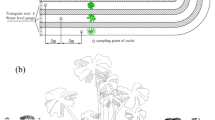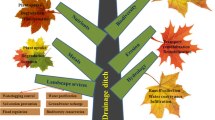Abstract
Ditches grown with nature reed (Phragmites communis Trin) and wild rice (Zizania latifolia Turcz) were selected to study the removal capacity of agricultural non-point source pollutants so as to find a way to alleviate eutrophication in Lake Taihu. Ditches sediment from depths below 40 cm can accumulate organic matter and total nitrogen (TN). TN is correlated positively to organic matter in reed populated sediment and wild rice populated sediment. This suggests that the main composition of TN is organic nitrogen derived from plant decomposition. A significant negative relationship between TN and pH was found in reed and wild rice sediments. Seasonal harvest of helophyte vegetation is an effective method to remove N and P from wetlands. Organic matter and TN concentrations in water and sediments (0–20 cm) in areas where reeds were removed are lower than non-harvested areas (control). Reeds and wild rice have high uptake ability of nitrogen (N) and phosphorus (P). However, the low economic value of these plants will not stimulate voluntary harvest of farmers. Zizania caduciflora Turez Hand-mazt is a kind of vegetable widely cultivated in ditches around the lake. It can also absorb N and P effectively. Thus, large scale cultivation of Z. caduciflora to replace nature plants may improve water quality.









Similar content being viewed by others
References
Angle, J. S., C. M. Gross, R. L. Hill & M. S. McIntosh, 1993. Soil nitrate concentrations under corn as affected by tillage, manure, and fertilizer application. Journal of Environmental Quality 22: 141–147.
Arheimer, B. & H. B. Wittgren, 1994. Modelling the effects of wetlands on regional nitrogen transport. Ambio 23: 378–386.
Bai, J., W. Deng & Y. Zhang, 2002. Spacial distribution characteristics of soil organic matter and nitrogen in the natural floodplain wetland. Environmental Science 23: 77–81 (in Chinese).
Berit, A. & B. W. Hans, 2002. Modelling nitrogen removal in potential wetlands at the catchment scale. Ecological Engineering 19: 63–80.
Borin, M., G. Bonaiti & L. Giardini, 2001. Controlled drainage and wetlands to reduce agricultural pollution: a lysimetric study. Journal of Environmental Quality 30: 1330–1340.
Braskerud, B. C., 2002. Factors affecting nitrogen retention in small constructed wetlands treating agricultural non-point source pollution. Ecological Engineering 18: 351–370.
China Standard Press, 1998. A Compilation of National Environmental Quality and Pollution Discharge Standards. China Standard Press, Beijing (in Chinese).
DeSimone, L. A., 1998. Nitrogen transport and transformations in a shallow aquifer receiving wastewater discharge: a mass balance approach. Water Resources Research 34: 271–285.
Eriksson, P. G. & S. E. B. Weisner, 1997. Nitrogen removal in a wastewater reservoir: the importance of denitrification by epiphytic biofilms on submersed vegetation. Journal of Environmental Quality 26: 905–910.
Fleischer, S., A. Gustafson, A. Joelsson, J. Pansar & L. Stibe, 1994. Nitrogen removal in created ponds. Ambio 23: 349–357.
Gao, C., J. Zhu & Y. Dou, 2002. Contribution of agricultural non-point source pollution to water quality deterioration in Taihu Lake watershed: recent trends and research priorities. Resources and Environment in the Yangtze Basin 11: 260–263 (in Chinese).
Huang, Y., C. Fang, P. Pu, J. Jiang & Q. Dai, 2001. Water Environment and Pollution Control of Lake Taihu. Science Publishing Company, Beijing, China, 259–264 (in Chinese).
Jan, V., 2002. The use of sub-surface constructed wetlands for wastewater treatment in the Czech Republic: 10 years experience. Ecological Engineering 18: 633–646.
Jordan, T. E., D. F. Whigham, K. H. Hofmockel & M. A. Pittek, 2003. Nutrient and sediment removal by a restored wetland receiving agricultural runoff. Journal of Environmental Quality 32: 1534–1547.
Kang, S., H. Kang, D. Ko & D. Lee, 2002. Nitrogen removal from a riverine wetland: a field survey and simulation study of Phragmites japonica. Ecological Engineering 18: 467–475.
Kovacic, D. A., M. B. David, L. E. Gentry, K. M. Starks & R. A. Cooke, 2000. Effectiveness of constructed wetlands in reducing nitrogen and phosphorus export from agricultural tile drainage. Journal of Environmental Quality 29: 1262–1274.
Li, S. & J. Li, 2001. Research progress on losses of fertilizer nitrogen. Agro-Environmental Protection 20: 377–379 (in Chinese).
Li, W., 1997. “Yellow water” in East Taihu Lake caused by Zizania latifolia and its prevention. Journal of Lake Sciences 9: 364–368 (in Chinese).
Liu, C., H. Hu & J. Zhang, 2002. Use of new type constructed wetland for treatment of low strength rural sewage. China Water and Wastewater 18: 1–4 (in Chinese).
Martin, H. W., D. B. Ivanoff, D. A. Graetz & K. R. Reddy, 1997. Water table effects on histosol drainage water carbon, nitrogen, and phosphorus. Journal of Environmental Quality 26: 1062–1071.
Mitsch, W. J., A. J. Horne & R. W. Nairn, 2000. Nitrogen and phosphorus retention in wetlands-ecological approaches to solving excess nutrient problems. Ecological Engineering 14: 1–7.
Peder, G. E. & E. B. W. Stefan, 1997. Nitrogen removal in a wastewater reservoir: the importance of denitrification by epiphytic biofilms on submersed vegetation. Journal of Environmental Quality 26: 905–910.
Qin, B. Q, P. Z. Xu, Q. L. Wu, L. C. Luo & Y. L. Zhang, 2007. Environmental issues of Lake Taihu, China. Hydrobiologia 581: 3–14.
Qiu, J., J. Jiang, B. Cao, L. Li, X. Xu & X. Han, 2002. Content and change trend of N, P, K in above ground organs of Zizania latifolia. Journal of Hubei Agricultural College 22: 22–125 (in Chinese).
Raisin, G. W. & D. S. Mitchell, 1995. The use of wetlands for the control of non-point source pollution. Water Science and Technology 32: 177–186.
Reddy, K. R. & W. H. Patrick, 1975. Effect of alternate aerobic and anaerobic conditions on redox potentical, organic matter decomposition and nitrogen loss in a flooded soil. Soil Biology & Biochemistry 7: 87–94.
Rene, L., Z. Malgorzata & B. Z. Joy, 1991. Nitrogen assessments in a constructed and a natural salt marsh of San Diego Bay. Ecological Applications 1: 40–51.
Rickerl, D. H., L. L. Janssen, & R. Woodland, 2000. Buffered wetlands in agricultural landscapes in the Prairie Pothole regions: environmental, agronomic, and economic evaluations. Journal of Soil and Water Conservation 55: 220–225.
Roth, G. W. & R. H. Fox, 1990. Soil nitrate accumulations following nitrogen-fertilized corn in Pennsylvania. Journal of Environmental Quality 19: 243–248.
Spieles, D. J. & W. J. Mitsch, 2000. The effects of season and hydrologic and chemical loading on nitrate retention in constructed wetlands: a comparison of low-and high-nutrient riverine systems. Ecological Engineering 14: 77–91.
Tanner, C. C., 2001. Growth and nutrient dynamics of soft-stem bulrush in constructed wetlands treating nutrient-rich wastewaters. Wetlands Ecology and Management 9: 49–73.
Tanner, C. C., R. H. Kadlec, M. M. Gibbs, J. P. S. Sukias & M. L. Nguyen, 2002. Nitrogen processing gradients in subsurface-flow treatment wetlands-influence of wastewater characteristics. Ecological Engineering 18: 499–520.
Withers, P. J. A., S. D. Clay & V. G. Breeze, 2001. Phosphorus transfer in runoff following application of fertilizer, manure, and sewage sludge. Journal of Environmental Quality 30: 180–188.
Xu, Q., 1996. A review on the status of non-point source pollution of chemical fertilizers and pesticides in China. Rural Eco-Environment 12: 39–43 (in Chinese).
Yang, Q., 1998. Ecological functions of aquatic vegetation in East Taihu Lake and its reasonable regulation. Journal of Lake Sciences 10: 76–72 (in Chinese).
Yang, Y., C. Tian, J. Sheng & Q. Wen, 2002. Spatial variability of soil organic matter, total nitrogen, phosphorus and potassium in cotton field. Agricultural Research in the Arid Areas 20: 26–30 (in Chinese).
Acknowledgements
We wish to express deep appreciation to associate Prof. L. Wang, Prof. A. J. M. Smits and A. Gashaw for valuable comments on the manuscript. We thank Junji Zhang for his practical assistance. The National Natural Science Foundation of China (No.50579018, 50239030) supported this study.
Author information
Authors and Affiliations
Corresponding author
Rights and permissions
About this article
Cite this article
Jiang, C., Fan, X., Cui, G. et al. Removal of agricultural non-point source pollutants by ditch wetlands: implications for lake eutrophication control. Hydrobiologia 581, 319–327 (2007). https://doi.org/10.1007/s10750-006-0512-6
Issue Date:
DOI: https://doi.org/10.1007/s10750-006-0512-6




